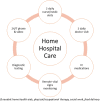Home hospital as a disposition for older adults from the emergency department: Benefits and opportunities
- PMID: 34322684
- PMCID: PMC8295243
- DOI: 10.1002/emp2.12517
Home hospital as a disposition for older adults from the emergency department: Benefits and opportunities
Abstract
The $1 trillion industry of acute hospital care in the United States is shifting from inside the walls of the hospital to patient homes. To tackle the limitations of current hospital care in the United States, on November 25, 2020, the Center for Medicare & Medicaid Services announced that the acute hospital care at home waiver would reimburse for "home hospital" services. A "home hospital" is the home-based provision of acute services usually associated with the traditional inpatient hospital setting. Prior work suggests that home hospital care can reduce costs, maintain quality and safety, and improve patient experiences for select acutely ill adults who require hospital-level care. However, most emergency physicians are unfamiliar with the evidence of benefits demonstrated by home hospital services, especially for older adults. Therefore, the lead author solicited narrative inputs on this topic from selected experts in emergency medicine and home hospital services with clinical experience, publications, and funding on home hospital care. Then we sought to identify information most relevant to the practice of emergency medicine. We outline the proven and potential benefits of home hospital services specific to older adults compared to traditional acute care hospitalization with a focus on the emergency department.
Keywords: Geriatrics; disposition; healthcare delivery; home hospital; palliative care; patient‐centered care.
© 2021 The Authors. JACEP Open published by Wiley Periodicals LLC on behalf of American College of Emergency Physicians.
Conflict of interest statement
Dr. Levine reports grant funding and codevelopment with Biofourmis and grant funding from IBM that is separate from the present work.
Figures
References
-
- CMS Announces Comprehensive Strategy to Enhance Hospital Capacity Amid COVID‐19 Surge. https://www.cms.gov/newsroom/press-releases/cms-announces-comprehensive-.... Published 2020. Accessed January 27, 2021.
-
- Leff B, Burton L, Mader SL, et al. Hospital at home: feasibility and outcomes of a program to provide hospital‐level care at home for acutely ill older patients. Ann Intern Med. 2005;143(11):798‐808. - PubMed
-
- Cryer L, Shannon SB, Van Amsterdam M, Leff B. Costs for ‘hospital at home’ patients were 19 percent lower, with equal or better outcomes compared to similar inpatients. Health Aff (Millwood). 2012;31(6):1237‐1243. - PubMed
-
- Tibaldi V, Isaia G, Scarafiotti C, et al. Hospital at home for elderly patients with acute decompensation of chronic heart failure: a prospective randomized controlled trial. Arch Intern Med. 2009;169(17):1569‐1575. - PubMed
Grants and funding
LinkOut - more resources
Full Text Sources


